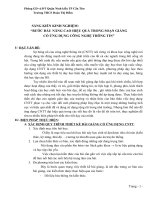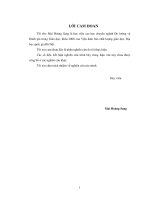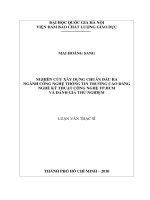Tài liệu phục vụ cho học tập nghiên cứu về Memory, tiếng anh chuyên ngành Công nghệ thông tin
Bạn đang xem bản rút gọn của tài liệu. Xem và tải ngay bản đầy đủ của tài liệu tại đây (5.07 MB, 41 trang )
Group 5
Computer
Memories
Members list
Nguyễn Thanh Tùng
Nguyễn Lê Thành Tâm
Nguyễn Trung Huy
Nguyễn Khánh Duy
Nguyễn Quốc Châu
Nguyễn Thị Mỹ Hạnh
Nguyễn Minh Trí
INTRODUCTION
OF MEMORIES
• What is a storage device
and why is it needed?
• An overview of
computer memory.
INTRODUCTION
What is a storage device?
• A storage device is a piece of computer
hardware used for saving, carrying and
pulling out data.
• It almost saves all data and applications
in a computer except for hardware
firmware.
• It comes in different shapes and sizes
depending on the needs and
functionalities.
INTRODUCTION
Types of Storage devices
Magnetic Storage Device
Optical Storage Device
uses lasers and lights as its mode of
saving and retrieving data.
Online and Cloud
is now becoming widespread as
people access data from different
devices.
one of the most popular types
of storage used.
Flash Memory Device
is now replacing magnetic storage
device as it is economical, more
functional and dependable.
Paper Storage
method used by early computers for
saving information.
INTRODUCTION
Why is Storage necessary?
All computers need storage. On a modern computer, storage comes in two forms:
temporary and long-term.
• Temporary storage: Supplied as memory, or RAM. Memory
is where the processor does its work, where programs run,
and where information is stored while it’s being worked on.
•
Long-term storage: Provided by storage media. Storage
media includes disk drives, flash drives, media cards, and
CDs and DVDs.
INTRODUCTION
An overview of
computer memory.
• A memory is used to store data and instructions.
• The memory is divided into large number of
small parts called cells.
Each location or cell has a unique address,
which varies from zero to memory size
minus one.
INTRODUCTION
Primary Memory/Main Memory
• Only holds those data and instructions on
which the computer is currently working.
• Has a limited capacity and data is lost
when power is switched off.
• Generally made up of semiconductor
device.
• Divided into two subcategories RAM and
ROM.
INTRODUCTION
Secondary Memory
• Known as external memory or non-volatile.
• Slower than the main memory.
• Used for storing data/information permanently.
•
CPU directly does not access these
memories, instead they are accessed via
input-output routines.
• For example, disk, CD-ROM, DVD, etc
TYPES OF
MEMORIES
• Primary or main memory
• Secondary memory
TYPES OF MEMORIES
Primary Or Main Memory
• Refers to physical memory that is internal to the
computer.
• The word “main” is used to distinguish it from external
mass storage devices such as disk drives.
• Other terms used to mean main memory include RAM
and primary storage.
TYPES OF MEMORIES
Functions and Features
Uses semiconductor
memory: ROM & RAM.
Contains information
(data, programs) that the
Processing speed
Its capacity is
CPU can exchange
is very fast.
not large.
directly.
TYPES OF MEMORIES
Cache Memory
CPU
• Cache can be either a reserved section of main
Cache
Memory
memory or an independent high-speed storage device.
• Two types of caching are commonly used in personal
Primary
Memory
computers: memory caching and disk caching.
Secondary
Memory
TYPES OF MEMORIES
Memory caching:
• A cache store or RAM cache.
• A portion of memory made of high-speed static
RAM (SRAM).
• Effective
TYPES OF MEMORIES
Disk caching:
• Disk caching can dramatically improve
the performance of applications.
• Disk caching works under the same principle as memory caching, but instead
of using high-speed SRAM, a disk cache uses conventional main memory.
TYPES OF MEMORIES
L1 & L2 cache:
Some memory caches are built into the architecture of microprocessors are often
called Level 1 (L1) caches.
TYPES OF MEMORIES
L1 & L2 cache:
• Most modern PCs also come with external cache
memory, called Level 2 (L2) caches.
These caches sit between the CPU and the DRAM.
L2 caches are composed of SRAM but they are
much larger.
• Higher-end systems and CPUs can include additional
layers of caching, such as L3 and higher.
Intel® Pentium® Gold
G6500T Processor (4M
Cache, 3.50 GHz)
TYPES OF MEMORIES
Cache In Web Browsing:
• Play an important role in the web browsing and
web development experience
Sometimes referred to as web cache, httpcache or proxy cache.
• Web browsers can store frequently accessed data like web pages or images on
the hard drive.
• Web servers also must clear cache so the most recent version of a website can be
displayed to users.
TYPES OF MEMORIES
RAM
• Stands for random access memory.
• An internal memory of CPU for storing data,
program and results of program, while it is
being executed.
• A read/write memory.
• Access time is independent of the address.
• A volatile memory, it mean that its content are
lost when the power is turned off.
TYPES OF MEMORIES
Types of Ram:
DRAM
• Stands for dynamic random access memory.
• Dram recharged or refreshed again and
again to maintain its content or data.
• Processor cannot access the data or content of dram when it is being
refreshed that’s why it is slow.
• It is least expensive kind of ram.
TYPES OF MEMORIES
SRAM
• Stands for Static Random Access Memory.
• Memory retains its content as long as power
is being supplied due to its volatile nature.
• Does not need to wait to access data from
SRAM during processing.
• Normally used to build a very fast memory
known as cache memory.
• More expensive.
TYPES OF MEMORIES
ROM
• A read-only memory (ROM) is a computer memory
on which data has been pre-recorded.
• Once data has been written onto a ROM chip, it
cannot be removed and can only be read.
• Unlike main memory (RAM), ROM retains its
contents even when the computer is turned off.
• ROM is referred to as being non-volatile, whereas
RAM is considered volatile.
TYPES OF MEMORIES
Types of Rom:
PROM Programmable Read
Only Memory
EPROM - Erasable
Programmable Read
Only Memory.
EEPROM -Electrically
Erasable Programmable
Read Only Memory.
TYPES OF MEMORIES
PROM
• Used in digital electronic devices to store
permanent data
• Usually low level programs such as firmware
or microcode.
• The data is programmed into them after
manufacture.









